Waterless Cosmetic Market Summary, 2031
The global waterless cosmetic market size was at $8.8 billion in 2021, and is projected to reach $22 billion by 2031, growing at a CAGR of 9.9% from 2022 to 2031.The market is segmented into Product, Gender, Nature and Distribution Channel.Waterless cosmetics category offers various cosmetic products such as skin care, hair care, makeup, and others. This waterless cosmetics products have low use of preservatives means less skin irritation. This is one of the major factors behind growing preferences for waterless cosmetics, as these formulas prevent occurrence of rashes, redness, itchiness, or any other type of reaction. 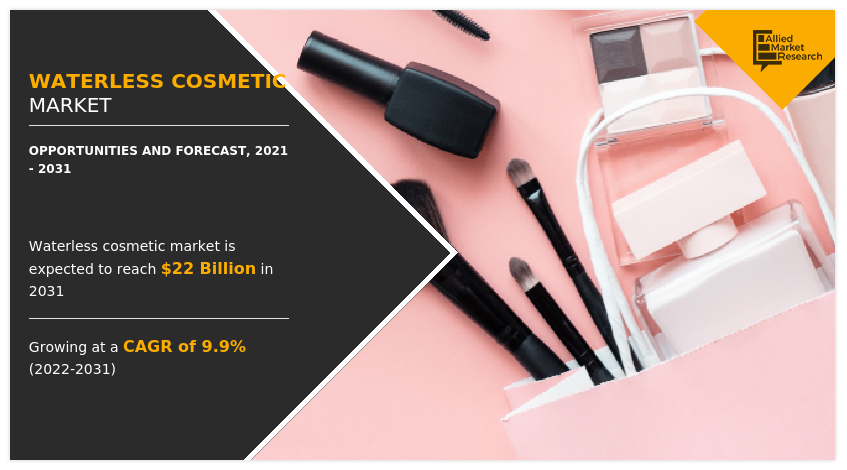
In addition, beauty conscious consumers today are increasingly looking for sustainable and healthier alternatives when it comes to beauty products. However, the waterless cosmetics are more expensive as compared to traditional cosmetics and skincare products. As waterless products are highly concentrated their prices are comparatively high.
The waterless cosmetic market demand is increasing due to inclination of customer’s preference toward looks and beauty. As customers are adopting an eco-friendly lifestyle with growing awareness regarding waterless cosmetics, they prefer products that are rich anti-aging and beautifying agents.
Although cosmetics serve as a good option for making an improvement in appearance, but their over usage leads to skin irritations and skin damage. For long-lasting benefits, consumers are switching toward organic cosmetics, as they are high in nature-based ingredients and organic cosmetic also doesn’t have any side effects.
Cosmetics containing natural ingredients such as aloe vera, tea extract, lime content, black sugar, and similar others propel the growth of the natural waterless cosmetic market. The waterless cosmetic market has already evolved in countries such as the U.S., Canada and Europe, therefore, the market is growing at a steady rate in these countries.
Moreover, to improve sales, manufacturers of waterless cosmetic products are capitalizing on rise in consumer interest in medicated cosmetics and have started investments for manufacturing products with natural ingredients. In addition, changing behavior of consumers toward healthier lifestyles is another major factor that drives the growth of natural waterless cosmetic market share. This, in turn, supplements the growth of the global waterless cosmetic market. Rapid change in climatic conditions in various regions influences increase in need for skin and sun care cosmetic products among customers.
Skin care products have gained demand from both men and women. Anti-ageing creams are in high demand among women, who are aged between 45 and 65 years. Hence, rise in trend of using skin care products among individuals across varied age group propels the growth of the global waterless cosmetic market.
Chemicals used in manufacturing of cosmetic products can harm an individual’s skin or other parts of their body. For instance, long-term use of waterless skin cosmetics can affect skin and extensive use of chemical rich shampoos, serums, and conditioners leading to heavy hair fall problem.
In addition, extensive use of color waterless cosmetic products for eyes and lips can also cause many diseases and consequential health hazards. Therefore, rise in awareness regarding potential side effects of waterless cosmetics and skin concerns among customers is an important factor that limits the waterless cosmetic market growth.
The rise in demand for natural and organically derived ingredients in waterless cosmetic and personal care products, has created new avenues in the Waterless Cosmetic Industry. In the recent years, organic skincare and waterless cosmetic products have witnessed exponential growth. Furthermore, hazardous effects to the skin have increased due to rise in pollution levels. Therefore, consumers have become extremely conscious about what goes onto their skin and hence there is an increase in preference for organic products. Many big players in the market such as L’Oréal, Unilever, Color Bar, and Avon are planning to invest increased budgets in an effort to promote natural aspects of their waterless cosmetics products.
E-commerce or online store is a huge platform growing at a tremendous rate worldwide. Consumers of every age, including generation X, millennial, or generation Z prefer to shop from e-stores. This is attributed to the fact that online shopping is more convenient as compared to shopping at physical stores, due to rise in number of retailers focusing on e-commerce, thus making it convenient for consumers.
Furthermore, increase in penetration of internet and rise in percentage of population inclining toward online shopping are expected to provide potential opportunity for the waterless cosmetic manufacturers to sell their existing as well as novel waterless cosmetic products through online platform, thus making them easily available for consumers and increasing consumer awareness about their products.
The global market is segmented into product type, gender, nature, distribution channel, and region. On the basis of product type, the market is classified into skincare, hair care, makeup and others. By gender, it is categorized into men and women.
Depending on nature, it is bifurcated into organic and synthetic. As per distribution channel, it is segregated into supermarkets & hypermarkets, specialty stores, online sales channel, and others. Region wise, the market is analyzed across North America, Europe, Asia-Pacific, and LAMEA.
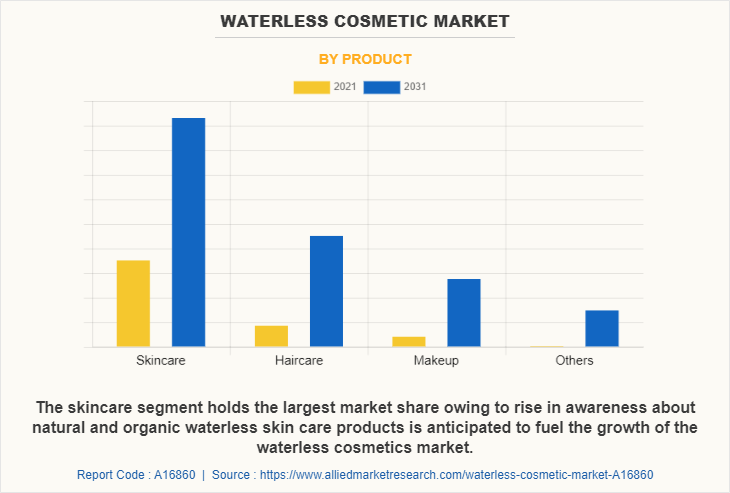
The skincare segment dominates the global waterless cosmetic market, skin care category is one of the most technically advanced, complex, and diverse categories of cosmetics. Products manufactured by companies have to undergo many dermatological tests before they are introduced for final use in the market. Waterless skin care products play a major role in daily healthcare regime of individuals.
Moreover, rise in awareness about natural and organic waterless skin care products is anticipated to fuel the growth of the Waterless Cosmetic Market. In addition, rise in consumer concerns regarding harmful effects of pollution and global warming positively influence demand for skin care products, globally. Rise in standard of living in emerging markets and inclined preference toward beauty are expected to fuel the market growth in the future.
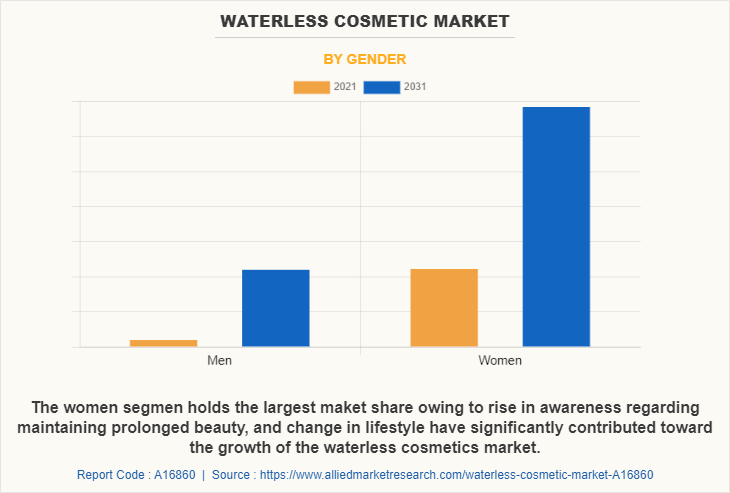
The waterless cosmetics are mostly preferred by women. The global market has witnessed continuous and sustained growth over years, owing to rise in beauty-conscious female population. Several other factors such as increase in female labor force, rise in awareness regarding maintaining prolonged beauty, and change in lifestyle have significantly contributed toward the market growth.
Furthermore, demand for herbal and natural waterless cosmetics products is on the rise among women, which is anticipated to increase at a substantial rate during the forecast period. In addition, brands such as the L’Oreal, and Hindustan Unilever Limited are indulged in producing herbal and natural waterless cosmetics products. Hence, rise in awareness regarding fashion and natural skin products significantly propels the growth of the market.
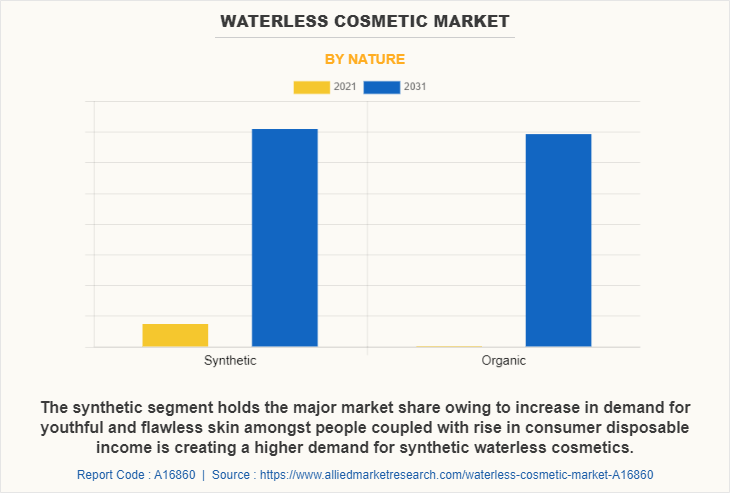
The synthetic cosmetic segment exhibits the fastest growth, low and easy availability of synthetic cosmetic products attract a large number of consumers.
In addition, these synthetic cosmetics are mostly in demand as they provide quick results to the customers. In addition, increase in demand for youthful and flawless skin amongst people coupled with rise in consumer disposable income is creating a higher demand for synthetic waterless cosmetics.
However, harmful ingredients used in making synthetic waterless cosmetic such as oxybenzone, synthetic scents, phthalates, and others are making negative impact on the synthetic cosmetic market. Developing regions of Europe and LAMEA are anticipated to provide great opportunities to the market during the waterless cosmetic market forecast period.
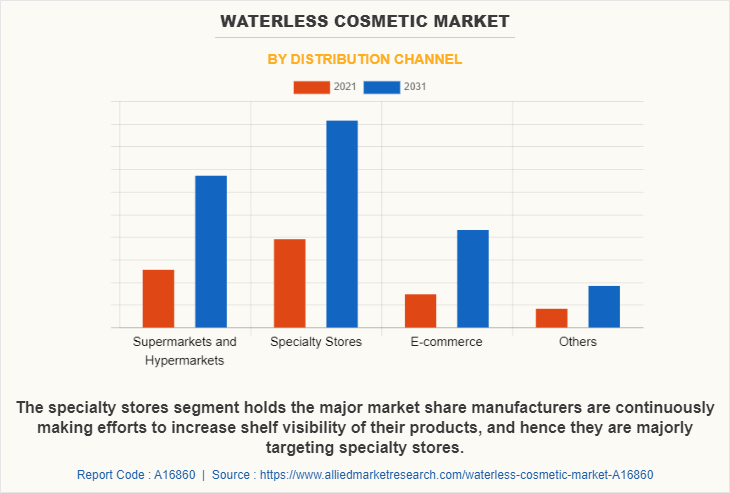
Consumers purchase waterless cosmetics through various distribution channels including supermarkets & hypermarkets, specialty stores, online sales channel, and others. The specialty channel is witnessing growth at the highest rate, owing to benefits provided such as discounts and customers can also perform product trial to verify product quality.
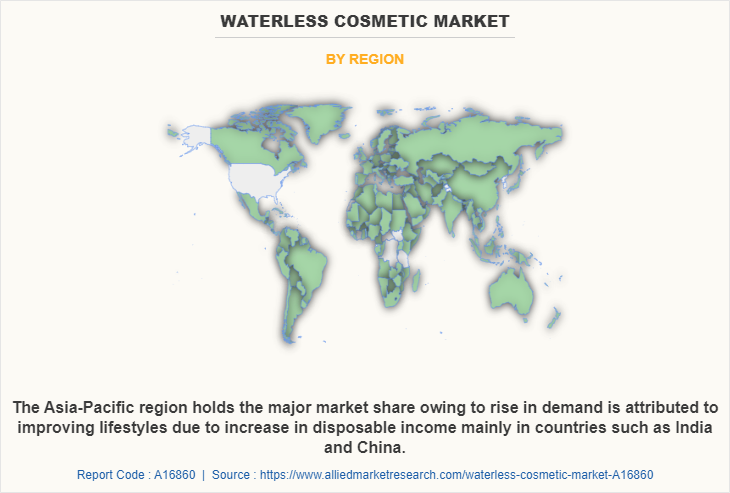
Region wise, Asia-Pacific dominated the market with the largest share during the forecast period. Companies operating in the Asia-Pacific waterless cosmetic market are innovating new products to sustain in the competitive market. They are launching new products to expand their business operations across different countries in this region and increase their customer base.
High spending capabilities of individuals, owing to increase in disposable incomes and economic stability are some of the major factors that propel the growth of the market. In addition, change in lifestyle of individuals contributes toward increase in sales of waterless cosmetics in Asia-Pacific
Waterless cosmetic and their different varieties are the mostly consumed in North America, especially in Canada, Mexico and the U.S. In this region, beauty experts, bloggers, and influencers play a major role in shaping the cosmetic industry. In addition, consumers are demanding natural beauty products and organic ingredients-based products, which in turn are propelling the market growth. Thus, the growing preference for looking beautiful and well-groomed has driven the demand for waterless cosmetic products among men and women in North America.
The major players analyzed for the waterless cosmetic industry are L’Oréal, Avon Products Incorporation, Procter and Gamble (P&G) Corporation, Unilever. Oriflame Cosmetics, Revlon Incorporation, Kao Corporation, Estee Lauder Companies Incorporation, Shiseido Company, Limited, Biotique, The Estée Lauder Companies Inc. Henkel Ag & Co. KGaA, Johnson & Johnson, Amway, and Coty Inc.
Key Benefits For Stakeholders
This report provides a quantitative analysis of the market segments, current trends, estimations, and dynamics of the waterless cosmetic market analysis from 2021 to 2031 to identify the prevailing waterless cosmetic market opportunity.
The market research is offered along with information related to key drivers, restraints, and opportunities.
Porter's five forces analysis highlights the potency of buyers and suppliers to enable stakeholders make profit-oriented business decisions and strengthen their supplier-buyer network.
In-depth analysis of the waterless cosmetic market segmentation assists to determine the prevailing market opportunities.
Major countries in each region are mapped according to their revenue contribution to the global market.
Market player positioning facilitates benchmarking and provides a clear understanding of the present position of the market players.
The report includes the analysis of the regional as well as global waterless cosmetic market trends, key players, market segments, application areas, and market growth strategies.
Waterless Cosmetic Market Report Highlights
| Aspects | Details |
| Market Size By 2031 | USD 22 billion |
| Growth Rate | CAGR of 9.9% |
| Forecast period | 2021 - 2031 |
| Report Pages | 330 |
| By Product |
|
| By Gender |
|
| By Nature |
|
| By Distribution Channel |
|
| By Region |
|
| Key Market Players | Unilever, L’Oréal, COTY INC, HENKEL AG & CO. KGAA, Oriflame Cosmetics, THE ESTÉE LAUDER COMPANIES INC, Procter and Gamble (P&G) Corporation, Biotique, Avon Products Incorporation, Amway, Estee Lauder Companies Incorporation, Johnson & Johnson, Kao Corporation, Revlon Incorporation, Shiseido Company, Limited |
Analyst Review
According to perspective of top-level CXOs, innovation is the key for growth of the waterless cosmetics market, in terms of value sales. Rise in demand for various waterless cosmetics products among customers makes way for manufacturers to come up with herbal or organic skin care products along with affordable prices and eco-friendly packaging. CXOs further added that rise in consciousness regarding physical appearance among individuals as well as working class professionals propels growth of the waterless cosmetics market. Use of natural ingredients such as aloe vera, tea, and black sugar in waterless cosmetics products reduce harmful effects of products, which drives growth of the waterless cosmetics market globally. The industry has recently observed an emerging trend of men using waterless cosmetic products in their daily lives. Use of cosmetics by men is expected to eventually increase and in turn supplement the growth of the global waterless cosmetics market.
Moreover, cosmetic products have witnessed prominent adoption in the developing countries such as China, owing to swift change in consumer lifestyle, increase in disposable income, and surge in need for waterless cosmetic products derived from natural extracts. Furthermore, increase in penetration of various online portals globally and rise in number of offers or discounts attract large consumer base to purchase skin care waterless cosmetics products through online channels. Moreover, online sales channel has increased consumer reach, making it key source of revenue for many companies.
Rise in awareness about natural and organic waterless skin care products is anticipated to fuel the growth of the waterless cosmetics market. In addition, rise in consumer concerns regarding harmful effects of pollution and global warming positively influence demand for skin care products, globally.
The global waterless cosmetic market to grow at a CAGR of 9.9% from 2022 to 2031.
Region wise, Asia-Pacific dominated the market with the largest share during the forecast period.
The global waterless cosmetic market was valued at $8,756.4 million in 2021 and is projected to reach $22,008.5 million by 2031.
The major players analyzed for the waterless cosmetic industry are L’Oréal, Avon Products Incorporation, Procter and Gamble (P&G) Corporation, Unilever. Oriflame Cosmetics, Revlon Incorporation, Kao Corporation, Estee Lauder Companies Incorporation, Shiseido Company, Limited, Biotique, The Estée Lauder Companies Inc. Henkel Ag & Co. KGaA, Johnson & Johnson, Amway, and Coty Inc.
Loading Table Of Content...



